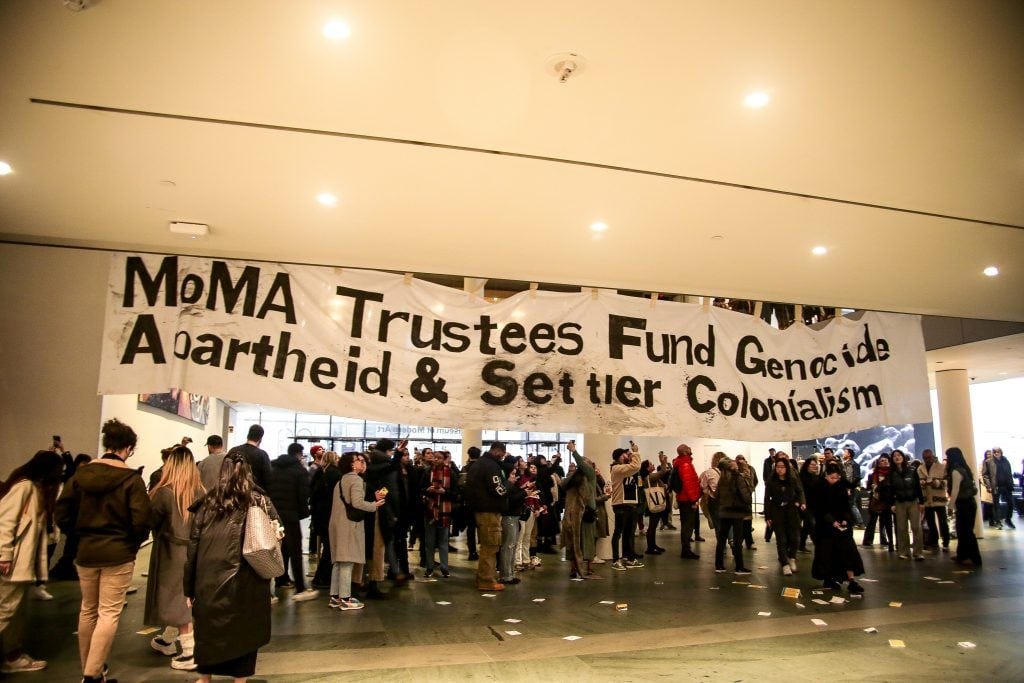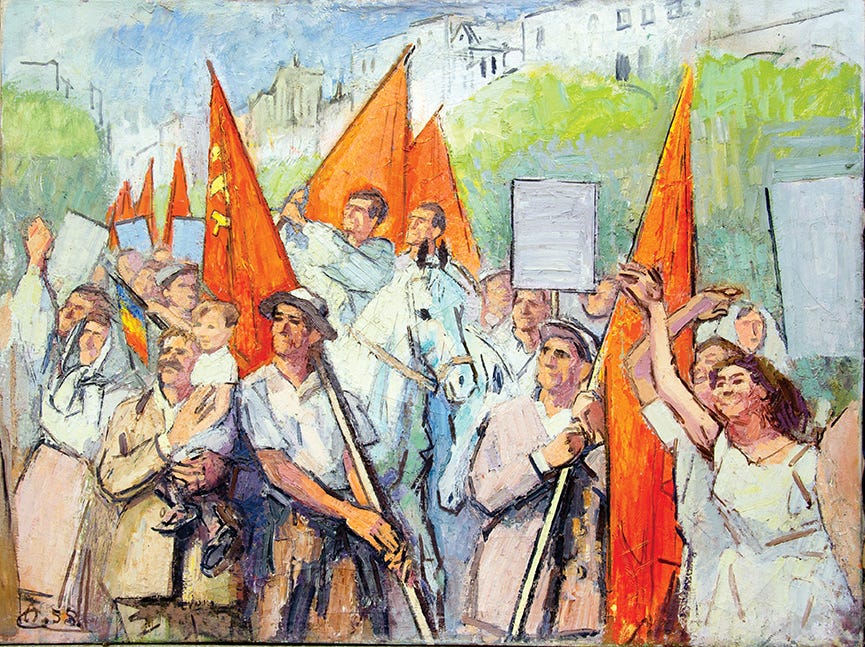Against Bourgeois Art
Reckoning with the Artist and Cultural Worker's Role in the Revolution
I read the following essay at a new recurring reading series called Again Bourgeois Art (hence the title of this essay) by my comrade Nico. If you are in Brooklyn/NY, do look out for the next ones!
—
You might know the phrase by Toni Cade Bambarra in which she describes her job as a cultural worker as making the revolution irresistible. I recently found the lesser-known elaboration of that thought in a conversation between her and a peer via this Ismatu Gwendolyn essay. She says:
“The task of the artist is determined always by the status and process and agenda of the community that it already serves. If you’re an artist who identifies with, who springs from, who is served by or drafted by a bourgeois capitalist class, then that’s the kind of writing you do. Your job is to maintain a status quo, to celebrate exploitation, or to guise in some lovely, romantic way. That’s your job.”
–
I majored in art history at university. Learning how to look at art expanded my ability to reflect deeply, but the question of these histories always occupied my mind. What histories were being focused on, and how were they taught?
For some reason, there were classes, even entire courses dedicated to Jackson Pollock’s work. What I learned was that this American artist refused subject vs. object and took to the canvas and splattered all over it in a flurry of his individualistic subconscious expression. His “abstract expressionism” was heralded as a signifier of his freedom as an individual artist, and hence, his liberty as a “free American man”. He could denounce form, escape reality, and even make his own. No matter how much these paintings were being shoved down my throat, I did not get it. They were not particularly interesting to me.
I learned recently that Jackson Pollock and his peers in the emerging Modern Art movement in America were being used by the CIA as a tool for the Cold War. Modern Art in all its abstract expressions was the perfect rival for Soviet art’s Socialist Realist paintings, which at the time were very popular, and mostly depicted Soviet workers in realistic paintings. Soviet artists painted these works to honour and build confidence in the people who were building a Communist society together.
The CIA created an anti-Communist group called the Congress for Cultural Freedom, and funneled money to MOMA to curate international art shows to target Soviet artists and intellectuals. Jackson Pollock’s splatters on the canvas particularly interested the CIA because these paintings were visually in opposition to the realistic paintings coming out of the Soviet Union at the time.
Pollock’s abstractions were latched on to and deemed as apolitical, and the CIA co-opted his work to further charge the anti-Communist narrative that deemed Soviet art as “authoritarian” and “rigid”, contrasting American art as free, compelling and the celebration of the artist’s individualistic expression. When we think of this strategy, we can apply it to how most bourgeois institutionally supported art is being used today. America is hellbent on depicting itself as a free democracy, which clearly, as we have seen since the dawn of its imperialist creations, is not the case.

I do not personally know whether Jackson Pollock’s politics or how he felt about the CIA’s cunning manouvers, but I tell this anecdote to highlight the fact that throughout history, and still today, Western Imperialists have long used art and culture as a tool for their violent agendas, and are particularly conniving in their plot to uphold bourgeois art.
Let me also make it clear that I am not making a case against abstract art, nor saying that we all need to start painting like the Soviet Socialist Realist painters. I am being critical of how artists are being exploited and used by art institutions as tools to uphold Imperialism. As cultural workers, we need to be weary, intentional, and firm in the struggle against the Capitalist ruling class.
So how can we anti-imperialists use the art that we make and combat their lechery? How can we make sure we are not being used?
–
I am not above admitting that my goals in art used to be rooted in scrambling for the attention of the art institution or the recognition of people in higher places. I am not above admitting that I used to determine my success with collaborations or invitations to stand in the hypnotic light of glamour and exclusivity. Like almost all of us, that is what I have been told to strive for.
However, it cannot be more clear to me now that these institutions have strategies and tangled relationships that only intend to exploit you for their Imperialist agendas. While dangling the carrot of wealth, comfort, or luxury in your face, they want you, as an artist, to demonstrate your so-called freedom of expression without ever being free. You can only say and feel what you want if you are willing to be part of the extractive, exploitative Capitalist society that they have built. You can be a “successful” artist if you are willing to be used as a tool. You can be a “successful” artist if you abandon and betray the working class.
I want to ask you simply: who is your art for? I am not saying we cannot make art for ourselves, and I am not against being expressive of the vitality of our emotions, but I want to ask you about your target audiences and your intentions. The Imperialists know how important art and culture is – do you?
As somebody who writes about emotions all the time, I started to wonder if my work held importance. However, I know emotions to be an outstanding force of power in the revolution, and furthermore, I know that my feelings do not stand alone. My feelings are inherently connected to everyone’s, and they are entangled in the rage, the grief, and the love that invigorates me to continue to resist Western Imperialism. I am not creating work to be heralded as the exceptional artist who feels an exceptional way, but as a person who is part of the intricate tapestry of emotions that have been felt throughout the people’s history when they combat Imperialism, and then recover and rebuild.
The bourgeois classes intend to isolate you and separate you from the people’s movement by fluffing your ego and tempting you with capital. While it is also a troubled trek that I am navigating myself, and I have by no means been perfect, I am trying with all my might to be steadfast in my intentions, to remember my audience as the people, specifically the working class, and to make my work accessible, retiring any aspiration for it to be behind institutional glass, and organising toward dismantling these Imperialist institutions altogether. What is the freedom of your individualistic expression if the people are not free? How do we use our voices to conjoin in a chorus of protest?
If the motivation behind your art is to slip into a place of wealth or comfort, fan your ego, and tend to the bourgeois classes just to get a seat at the table, then it is an active betrayal of the people, an active betrayal of those currently being slaughtered during a genocide. I would go further as to say that it is not art. Art is truth-telling, and you are lying.
Marxist academic Vijay Prashad once said that the revolution is artful. I let that thought twirl in my head for a while, because it sounded delightful, agitating and puzzling all at once. He said that insurrection is an art, and requires the following; Creation, Clarity and Confidence. Creation, which requires experimentation, reflection, being aligned and in touch with the truth, a truth not under the chokehold of an Imperialist agenda, but that which we must seek together.
What is art if not reaching out to the masses, being firm in your position with the popular classes, stating that you are willing to commit class suicide and seeing to the demise of the furlined trap of the art institution?
What is art if not trying to tell the truth by being present with and facing it? What is art if not trying, experimenting, in so many ways, with your hand, your brush, your voice, your vision, to articulate that which you see when you look at what is happening around us, flowers shedding their blossoms and bursting into lush green leaves, students setting up highly organised encampments to take care of each other while protesting a genocide, and the people, our elders and our children, all around the world, resisting every single day for a Free Palestine. What is art if not trying to depict and make sense of life, and hence, to fight tirelessly for it?
Further resources that help me sharpen my political education and think deeper of the role of the artist and cultural worker in the revolution:
Tings Chak’s class on Art, Culture and National Liberation at The People’s Forum’s 8-Week Course on Marxism and National Liberation
Culture as a Weapon of Struggle: The Medu Art Ensemble and Southern African Liberation by TriContinental
Organized Labor, Unions, Strikes and Palestine with Zaina Alsous and Venus Roots’ Getting to the Root of it









Thank you! it is so important for us to understand the power of culture and how it is exploiting us into valuing an extractive, destructive and oppressive war economy over the giving, sharing, caring, thriving, relational, resilient peace economy. It is time to pivot to creating, uplifting, engaging, and delighting in the peace economy, the interconnectedness of all life.
Thank you! Such a beautiful and vital message to wake up to this morning!